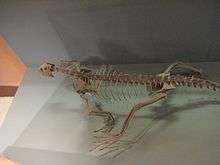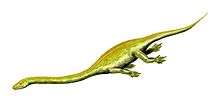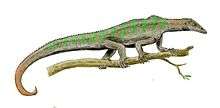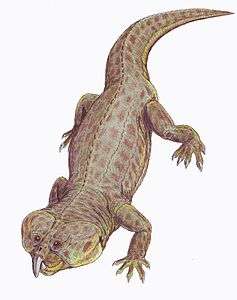Archosauromorpha
| Archosauromorphs | |
|---|---|
 | |
| Mounted skeleton of a primitive archosauromorph (Trilophosaurus buettneri) | |
| Scientific classification | |
| Kingdom: | Animalia |
| Phylum: | Chordata |
| Class: | Reptilia |
| Clade: | Sauria |
| Clade: | Archosauromorpha von Huene, 1946 |
| Subgroups[2] | |
| |
| Synonyms | |
|
Archelosauria Crawford et al., 2014 | |
Archosauromorpha (Greek for "ruling lizard forms") is a clade (or infraclass) of diapsid reptiles that first appeared during the middle Permian and became more common during the Triassic. It was defined by Jacques Gauthier, Arnold G. Kluge and Timothy Rowe (1988) as the group containing "archosaurs [i.e. Crocodylia, dinosaurs, birds, and several extinct orders] and all other saurians that are closer to archosaurs (s.s.) than they are to lepidosaurs (s.s.)" [i.e. tuataras, lizards, and snakes].[3] In a later publication, Michel Laurin (1991) defined Archosauromorpha as the clade containing the most recent common ancestor of Prolacerta, Trilophosaurus, Hyperodapedon and all its descendants;[4] David Dilkes (1998) formulated a more inclusive definition of Archosauromorpha, defining it as the clade containing Protorosaurus and all other saurians that are more closely related to Protorosaurus than to Lepidosauria.[5]
Classification
This clade includes many different groups, such as the Rhynchosauria, Allokotosauria (including Trilophosauridae and Azendohsauridae), Protorosauria (a possibly unnatural group including Protorosaurus and perhaps tanystropheids), prolacertids, and Archosauriformes. While superficially these reptiles vary in appearance (at one time they were even included in different subclasses – the trilophosaurs and protorosaurs were considered euryapsids and the rhynchosaurs were considered lepidosaurs and were included in the same order as the tuatara), they are actually united by a number of small skeletal and skull-related details that suggest they form a clade that descended from a single common ancestor. Additional groups with uncertain phylogenetic position that are included in Archosauromorpha by some authors (and excluded from it by others) are Choristodera, drepanosaurs,[5] thalattosaurs, ichthyopterygians, sauropterygians[6][7][8] and turtles.[9]
An advanced subgroup of Archosauromorpha is Crocopoda ("crocodile feet"). Crocopoda is defined as all Archosauromorphs more closely related to allokotosaurs (specifically Azendhosaurus and Trilophosaurus), rhychosaurs (specifically Rhynchosaurus), or Archosauriformes (specifically Proterosuchus) than to Protorosaurus or tanystropheids (specifically Tanystropheus). Many crocopods possess a prominent calcaneal tuber, a trait which is lost in some members of the group but retained in the extant crocodylians.[10]
Many groups of archosauromorphs died out at or before the end-Triassic extinction. The choristoderans continued as a minor group until their extinction in the Miocene, and the Archosauriformes were important factors in early Triassic environments before giving rise to the even more successful Archosauria.
Relationships
The cladogram shown below follows the most likely result found by an analysis of turtle relationships using both fossil and genetic evidence by M.S. Lee, in 2013.[11]
| Sauria |
| ||||||||||||||||||||||||||||||||||||||||||||||||||||||||||||
The following cladogram is based on a large analysis of archosauriforms published by M.D. Ezcurra in 2016.[2]
| Sauria |
| ||||||||||||||||||||||||||||||||||||||||||||||||||||||||||||||||||||||||
See also

- List of archosaurs of the Chinle Formation
References
- ↑ Agustín G. Martinelli; Heitor Francischini; Paula C. Dentzien-Dias; Marina B. Soares; Cesar L. Schultz (2017). "The oldest archosauromorph from South America: postcranial remains from the Guadalupian (mid-Permian) Rio do Rasto Formation (Paraná Basin), southern Brazil". Historical Biology. 29 (1): 76–84. doi:10.1080/08912963.2015.1125897.
- 1 2 Ezcurra, Martín D. (2016). "The phylogenetic relationships of basal archosauromorphs, with an emphasis on the systematics of proterosuchian archosauriforms". PeerJ. 4: e1778. doi:10.7717/peerj.1778. PMC 4860341. PMID 27162705.
- ↑ Jacques Gauthier; Arnold G. Kluge; Timothy Rowe (1988). "Amniote phylogeny and the importance of fossils". Cladistics. 4 (2): 105–209. doi:10.1111/j.1096-0031.1988.tb00514.x.
- ↑ Michel Laurin (1991). "The osteology of a Lower permian eosuchian from Texas and a review of diapsid phylogeny". Zoological Journal of the Linnean Society. 101 (1): 59–95. doi:10.1111/j.1096-3642.1991.tb00886.x.
- 1 2 David M. Dilkes (1998). "The Early Triassic rhynchosaur Mesosuchus browni and the interrelationships of basal archosauromorph reptiles". Philosophical Transactions of the Royal Society of London, Series B. 353 (1368): 501–541. doi:10.1098/rstb.1998.0225. PMC 1692244.
- ↑ John W. Merck (1997). "A phylogenetic analysis of the euryapsid reptiles". Journal of Vertebrate Paleontology. 17 (Supplement to 3): 65A. doi:10.1080/02724634.1997.10011028.
- ↑ Sean Modesto; Robert Reisz; Diane Scott (2011). "A neodiapsid reptile from the Lower Permian of Oklahoma". Society of Vertebrate Paleontology 71st Annual Meeting Program and Abstracts: 160.
- ↑ http://www.geol.umd.edu/~tholtz/G331/lectures/331vertsII.html
- ↑ Bhart-Anjan S. Bhullar; Gabe S. Bever (2009). "An archosaur-like laterosphenoid in early turtles (Reptilia: Pantestudines)" (PDF). Breviora. 518: 1–11. doi:10.3099/0006-9698-518.1.1.
- ↑ Ezcurra, Martín D. (2016-04-28). "The phylogenetic relationships of basal archosauromorphs, with an emphasis on the systematics of proterosuchian archosauriforms". PeerJ. 4: e1778. doi:10.7717/peerj.1778. ISSN 2167-8359. PMC 4860341. PMID 27162705.
- ↑ Lee, M. S. Y. (2013). "Turtle origins: Insights from phylogenetic retrofitting and molecular scaffolds". Journal of Evolutionary Biology. 26 (12): 2729–38. doi:10.1111/jeb.12268. PMID 24256520.
_(Varanus_griseus).png)




